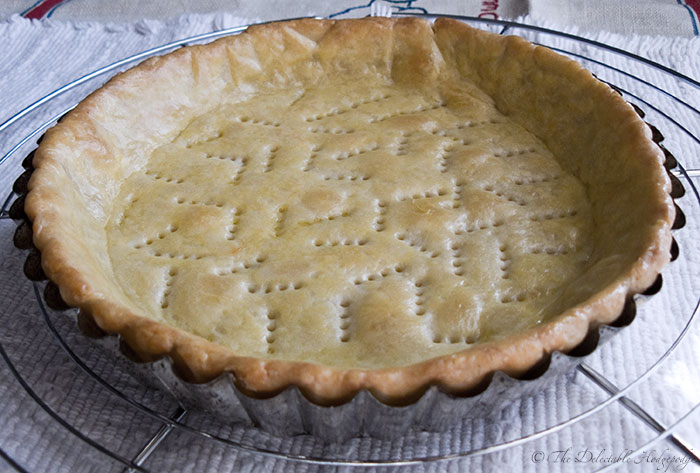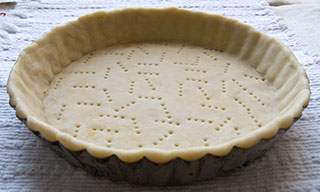
Pâte Sucrée
| Ingredient | 2 7-inch Tarts | 2 18-20cm Tarts |
|---|---|---|
| cake flour | 10 oz. | 280g |
| unsalted butter | 10 Tbsp. | 140g |
| powdered sugar | 3 oz. | 90g |
| egg yolk | 2 | 2 |
| egg white | 1 (to brush) | 1 (to brush) |
| salt | pinch | pinch |
This sweet, flaky tart shell is a little like shortbread, and forms the base of tarts, as well as some cakes and other confections.

Preparation
- Sift flour and powdered sugar, separately.
- Separate eggs.
- Let butter and egg yolk come to room temperature. Refrigerate egg white.
Directions
- Whip butter.
Briefly whip the softened butter with a whisk in a bowl. - Add salt and powdered sugar.
Add the salt to the bowl, then add the powdered sugar in thirds, whipping until creamy each time. - Add egg yolk.
Add the egg yolk, half at a time, stirring with the whisk until well mixed after each addition. - Add flour.
Add flour to the mixture and mix using a dough scraper or the sharp edge of a spatula in a cutting motion until completely combined, being careful not to overwork it. - Press and fold dough.
Gather up the dough, the press down on it with your fist to flatten it out somewhat. Fold in half, then press down again, and repeat once or twice more. - Wrap and let rest.
Ball the dough and wrap it tightly in plastic, then let rest for at least an hour in the refrigerator; letting it rest overnight is better. - Divide.
Cut the dough in half; wrap one half tightly and freeze unless you’re making two tarts. - Roll dough.
Place the dough between two pieces of plastic wrap or flour the rolling surface and rolling pin. Tap on the ball of dough with the rolling pin until it’s about half as thick, then roll it out until a little larger than the pan you’re going to cook it in. It should end up 3mm (1/8") thick. If the dough is too stiff to roll properly, let it warm up a bit until it’s soft enough to work. - Lay dough in pan.
To keep the sheet from tearing when you transfer it to the pan, peel the plastic wrap off one side of the dough and roll it gently onto the rolling pin, with the plastic wrap toward the pin, then unroll it onto the pan. - Press dough into pan.
Gently press the dough into the corners of the pan and remove the plastic wrap. - Cut away excess and even.
Roll the pin across the top of the pan to cut away any excess hanging over the edge. Use a fingertip to press the dough into the scalloped edge of the tart pan. If any places on the bottom are thicker or thinner than others use your thumbs to even them out. Use some of the dough you cut away to fill any holes or tears. Since it will shrink slightly when baked, press a small amount (2-3mm or 1/16") out above the edge of the pan. - Cover and let rest.
Cover the dough tightly with a piece of the plastic wrap, then let rest in the refrigerator for at least an hour. - Prick with fork.
Thoroughly prick the dough on the bottom of the pan with a fork; you want to poke holes all the way through the dough. - Bake.
When baking a filled tart, the goal is to blind bake it until it’s 80% done, then add the filling and bake the remaining 20%:
- Lay a piece of foil over the dough, then add some pie weights, rolling the foil down over the outside edge a little to keep it from burning.
- Bake at 200°C (400°F) for 15 minutes.
- Remove the weights and foil, then bake for another 5-10 minutes, until pale golden.
- Brush with the egg white and bake for 1-2 more minutes; this keeps the filling from making the tart soggy.
- Put the pan on a cake rack to let the tart cool before filling it, then bake according to the recipe.
If you’re going to be filling the tart after it’s fully baked:
- Lay a piece of foil over the dough, then add some pie weights, rolling the foil down over the outside edge a little to keep it from burning.
- Bake at 200°C (400°F) for 15 minutes.
- Remove the weights and foil, then bake for another 10-15 minutes, until golden brown.
- Brush with the egg white and bake for 1-2 more minutes; this keeps the filling from making the tart soggy.
- Put the pan on a cake rack to let the tart cool before filling it.
Notes
- The tart will tend to shrink while baking; letting it rest properly in the refrigerator both times will minimize this. Having it well-chilled right before baking will keep the butter firm until the dough begins to cook, which helps the tart keep its shape.
- The excess dough can be used to make shortbread cookies; roll it out and cut into whatever shape you like, then bake a 180°C (350°F) for 10 minutes.
- For a flakier tart crust, you can replace some of the flour with almond flour; use half as much almond flour as the amount of butter (70g/2.5 oz.) and reduce the cake flour by an equivalent amount (to 210g/7.4 oz.).
- The prepared dough can be frozen for several weeks. When you’re ready to use it, let it thaw gradually in the refrigerator.
